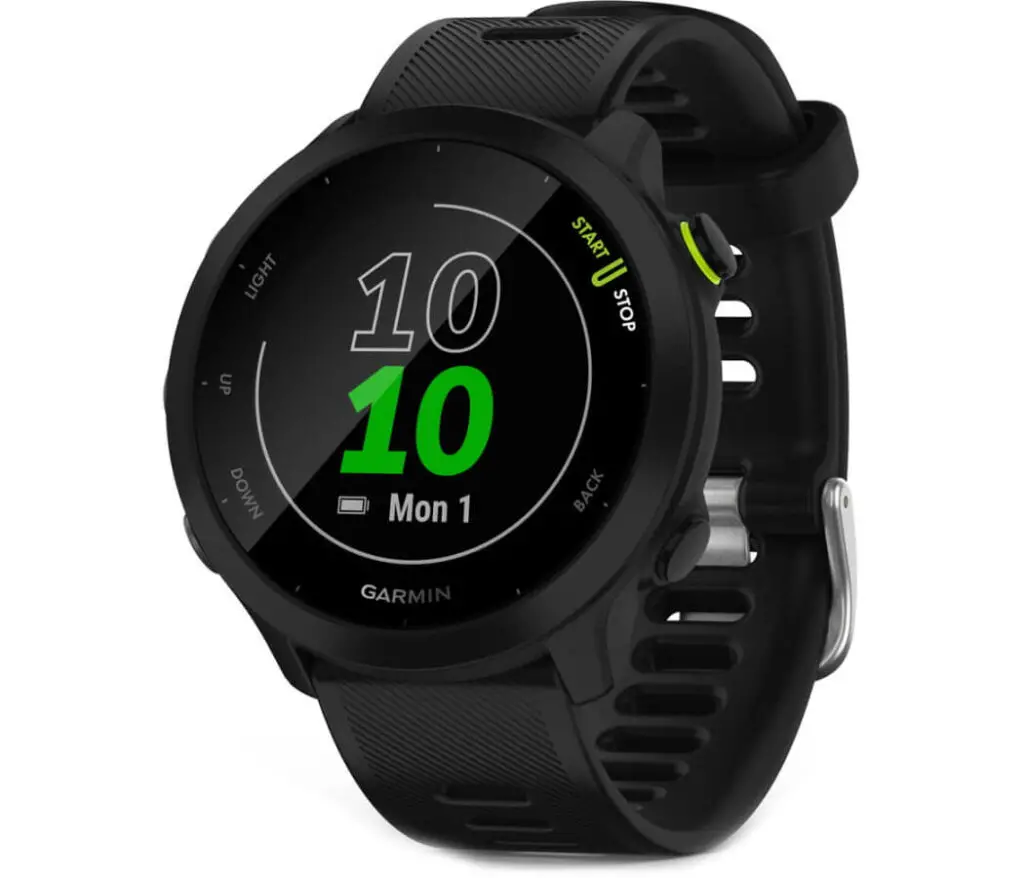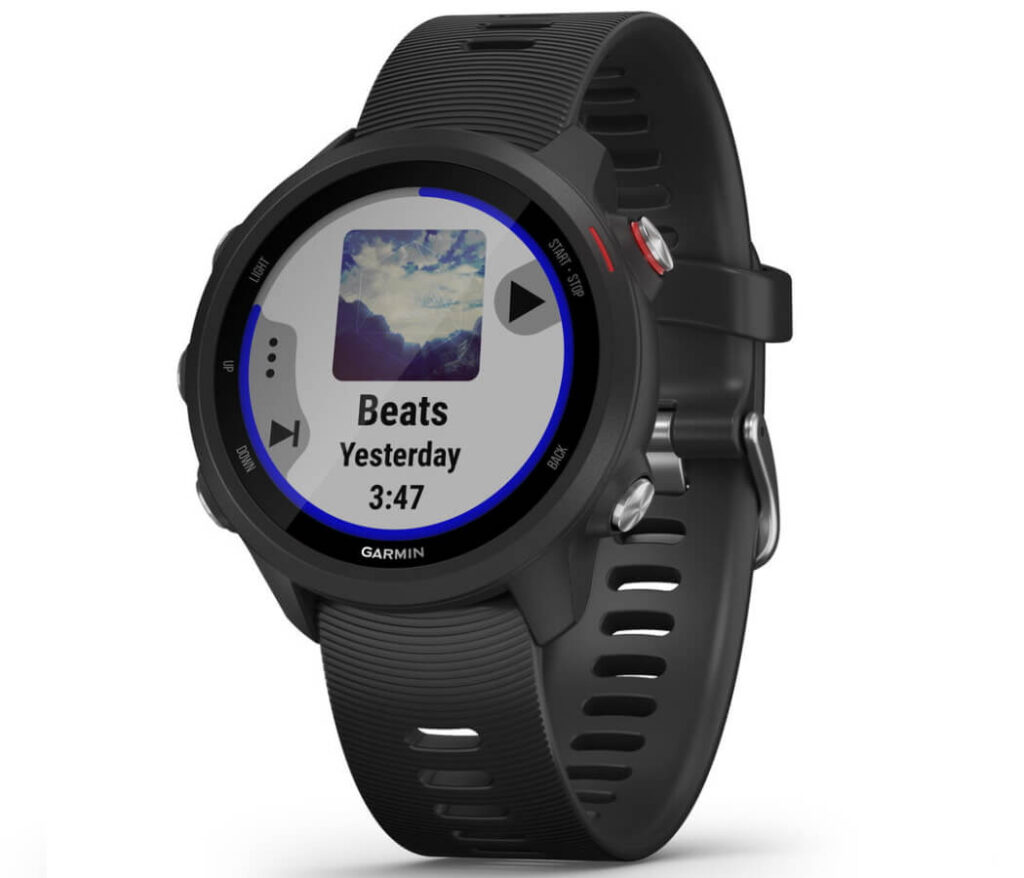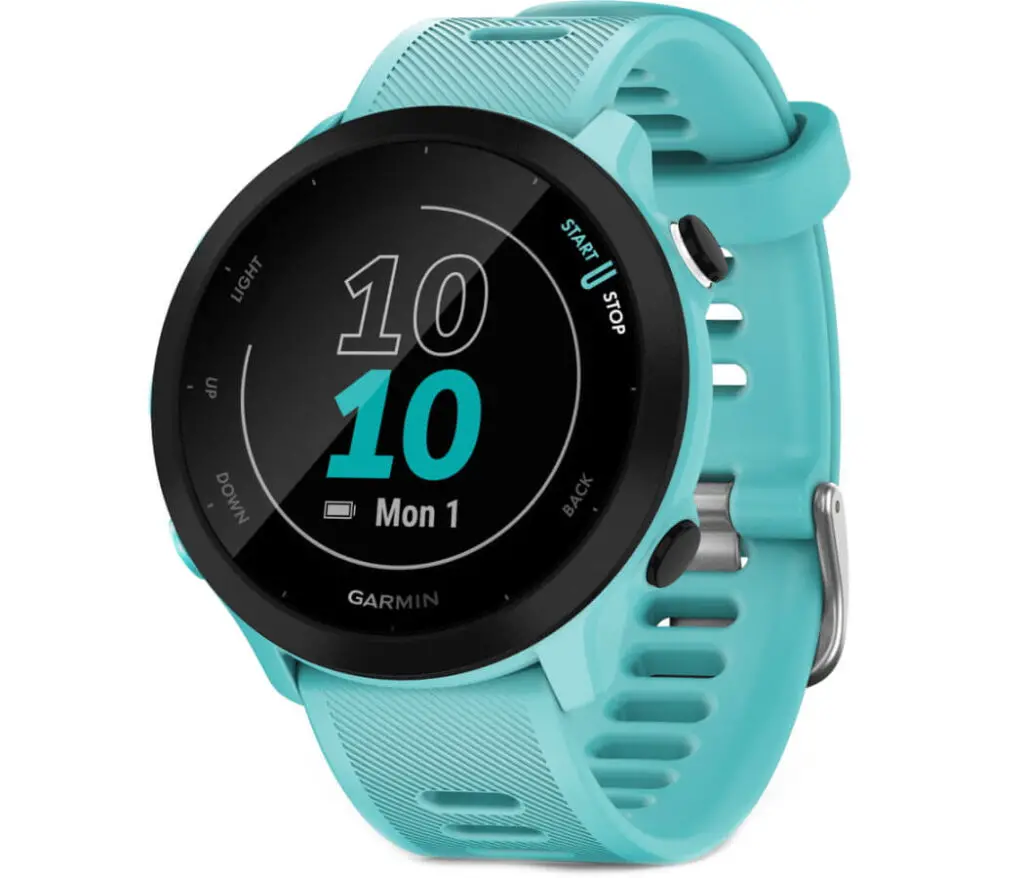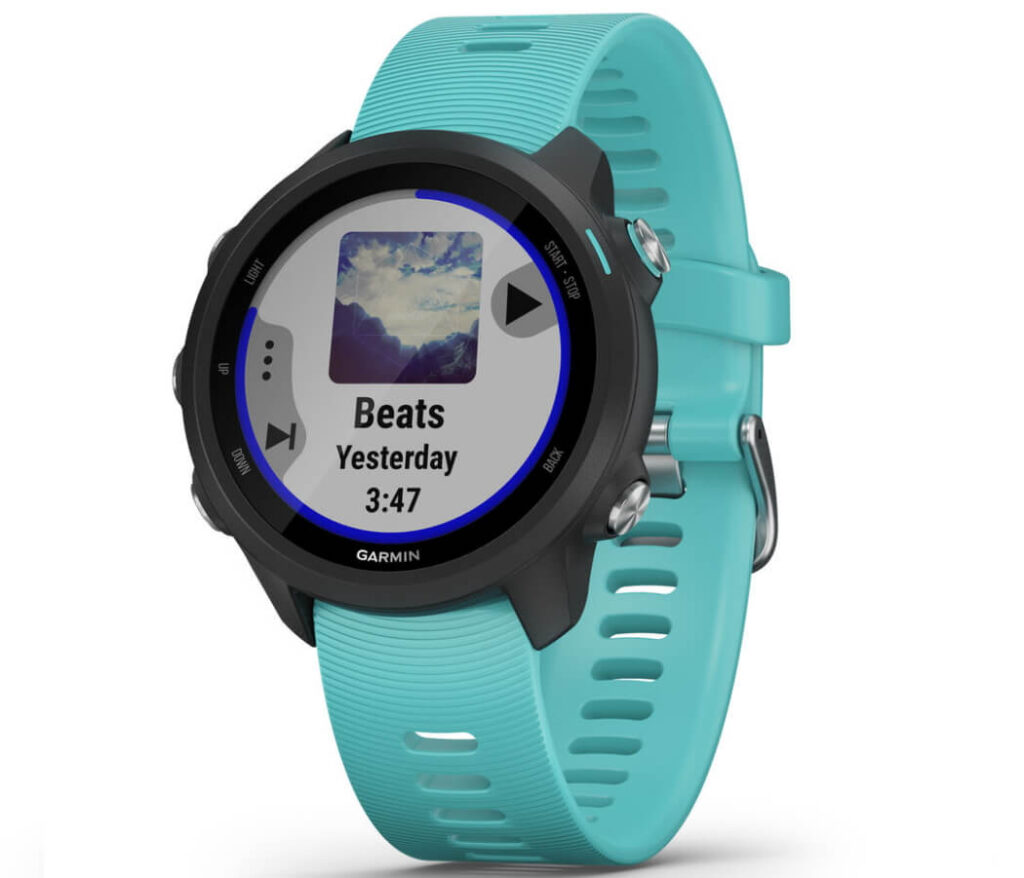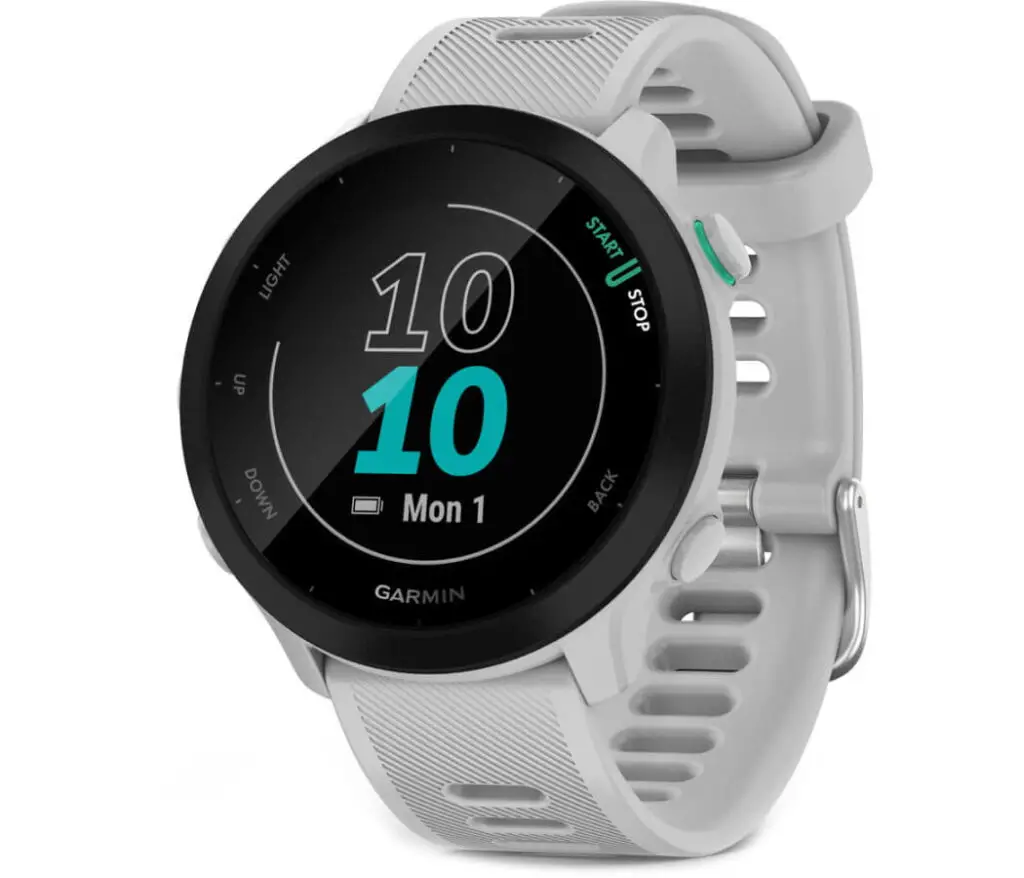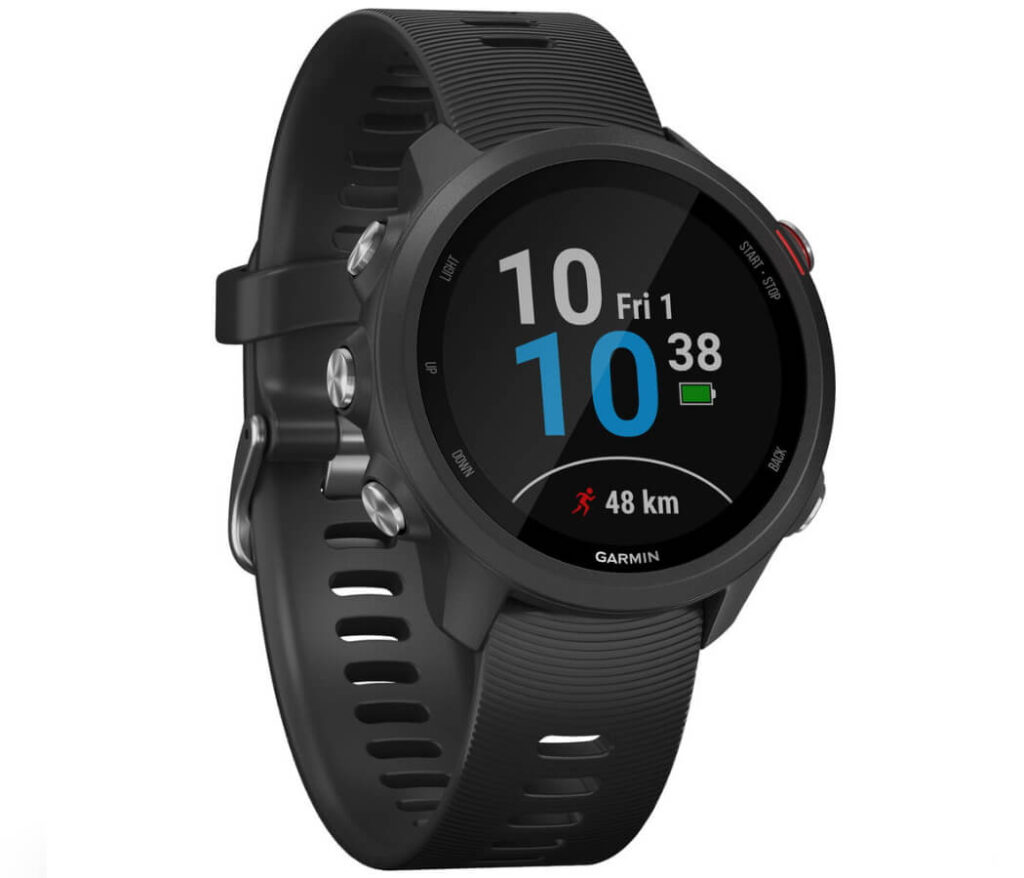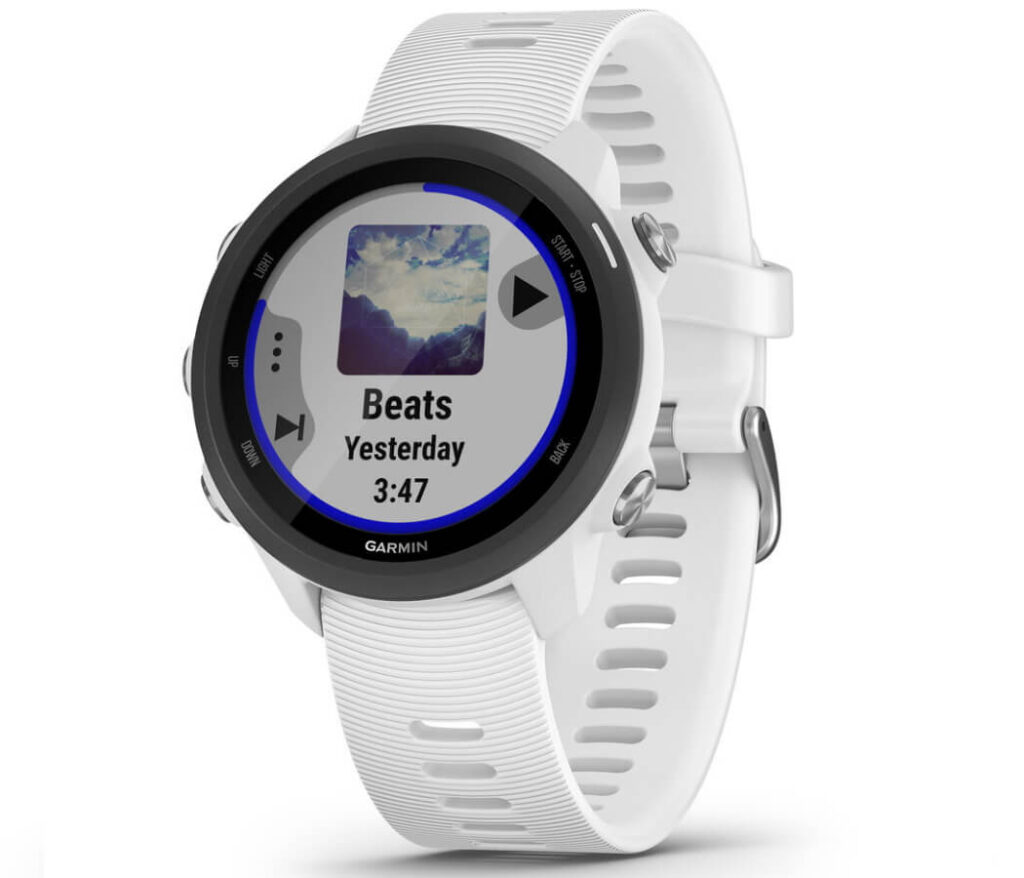The Garmin Forerunner 55 and the Garmin Forerunner 245 are actually surprisingly similar running watches.
Even though the FR55 is technically Garmin’s entry-level running watch, it can go toe-to-toe with the FR245 in terms of sports modes, running features, and activity tracking technology.
However, there are a few key differences between each device, with the music storage and advanced running dynamics being the biggest drawcards of the Forerunner 245.
Now let’s dive into the details of this Garmin Watch comparison. They are both valuable additions to the Garmin Forerunner Series.
Key Similarities - Garmin Forerunner 55 vs 245
FR55
FR245
Bluetooth®, ANT+®, Wi-Fi®
Bluetooth®, ANT+®, Wi-Fi®
5 ATM
5 ATM
Key Differences - Forerunner 55 vs 245
| PRODUCT | Forerunner 55 | Forerunner 245 |
| PHYSICAL SIZE | 42 x 42 x 11.6 mm | 42.3 x 42.3 x 12.2 |
| LENS MATERIAL | Chemically Strengthened Glass | Corning® Gorilla® Glass 3 |
| DISPLAY SIZE | 1.04″ (26.3 mm) diameter | 1.2″ (30.4 mm) diameter |
| DISPLAY RESOLUTION | 208 x 208 pixels | 240 x 240 pixels |
| WEIGHT | 37 grams | 38.5 grams |
| SMARTWATCH MODE BATTERY | Up to 2 weeks | Up to 7 days |
| GPS BATTERY | Up to 20 hours | Up to 24 hours |
| GPS + MUSIC BATTERY | N/A | Up to 6 hours |
| TOTAL RUNNING FEATURES | 11 | 16 |
| TOTAL SPORTS MODES | 14 | 15 |
| HIIT (INTERVAL TRAINING) | Yes | No |
| RESPIRATION RATE (24X7) | Yes | No |
| INDOOR ROWING | No | Yes |
| PULSE OX BLOOD OXYGEN | No | Yes |
| TRAINING LOAD | No | Yes |
| MUSIC STORAGE | No | Up to 500 Songs |
Running Features - FR55 vs FR245
Garmin Forerunner 55
- Running
- Treadmill Running
- Track Running
- Indoor Track Running
- Virtual Running
- Distance, Time & Pace
- Cadence
- PacePro Pacing Strategies
- Run Workouts
- Race Predictor
- Foot Pod Compatible
Garmin Forerunner 245
- Running
- Treadmill Running
- Track Running
- Indoor Track Running
- Virtual Running
- Distance, Time & Pace
- Cadence
- PacePro Pacing Strategies
- Run Workouts
- Race Predictor
- Foot Pod Compatible
- Trail Running
- Running Dynamics (with accessory)
- Vertical Oscillation and ratio (with accessory)
- Ground contact time (with accessory)
- Stride length (with accessory)
- Performance condition
Sports Tracking & Fitness Tracking Features
Garmin Forerunner 55
- Running
- Treadmill Running
- Track Running
- Indoor Track Running
- Virtual Running
- Cycling
- Indoor cycling
- Pool Swimming
- Cardio Training
- Elliptical Training
- Stair Stepping
- HIIT (High Intensity Interval Training)
- Pilates
- Yoga
Garmin Forerunner 245
- Running
- Treadmill Running
- Track Running
- Indoor Track Running
- Virtual Running
- Cycling
- Indoor cycling
- Pool Swimming
- Cardio Training
- Elliptical Training
- Stair Stepping
- Indoor Rowing
- Pilates
- Yoga
- Trail Running
Reasons To Choose The Forerunner 55

It's almost the same watch, but it cost $100 less
When you look at the specs of the Forerunner 55 side by side with the Forerunner 245, it should be pretty clear that these watches are very similar from a technical perspective.
By opting for the FR55, you essentially get all the main features of the FR245, with the exception of music storage and a few advanced running metrics.
Basically, if you don’t listen to music while you’re running outdoors, there isn’t all that much reason to go for the FR245. You can basically pocket that extra $100 and simply opt for the F55 instead.
Reasons To Choose The Forerunner 245

Advanced Running Metrics
The main advantage the Forerunner 245 has over the Forerunner 55 for runners specifically, is support for Garmin advanced running dynamics. This opens up the following running metrics on the FR245.
- Ground Contact Time – The time your foot spends on the ground with each stride.
- Ground Contact Balance – Symmetry between left and right foot when running.
- Vertical Oscillation – The amount of ‘bounce’ in your running motion. Reducing the amount of bounce in your stride can improve your running efficiency/economy.
- Vertical Ratio – the cost-benefit ratio with stride length. This stat can help you find the ideal stride length for setting new a PB, in any distance.
- Cadence – Real time cadence metrics, displayed on your watch
- Stride Length – Real time stride length data, displayed on your watch
However, it’s worth mentioning that in order to unlock these advanced running dynamics, you will need to invest in one of the following Garmin accessories.
- Garmin HRM-Run (Chest Strap)
- Garmin HRM-Tri (Chest Strap)
- Garmin Running Dynamics Pod
Music Storage
This is one of the key selling points of the FR245. You essentially get 3.5GB of music storage (about 500 songs) and you can also play music through the following apps:
- Spotify
- Deezer
- iHeartRadio
- Apple Music
Perhaps more importantly, music storage is quite literally the most compelling reason to choose the Forerunner 245 over the Forerunner 55. If you take this feature away, it makes sense to simply keep the extra money in your wallet and go for the FR55. In other words, music storage is a dealbreaker in this particular product comparison.
Final Thoughts
As you can see from this comparison, each fitness tracker has its place in the Garmin Forerunner series. However, if you are still on the fence, these final recommendations may help:
Go for the Garmin Forerunner 55 if:
- You are on a tight budget
- You don’t listen to music while you train
- You want an affordable yet well-rounded GPS running watch
Go for the Garmin Forerunner 245 if:
- You want built-in music storage
- Running is your primary sport and you want advanced running dynamics
- You want the better Garmin device overall


